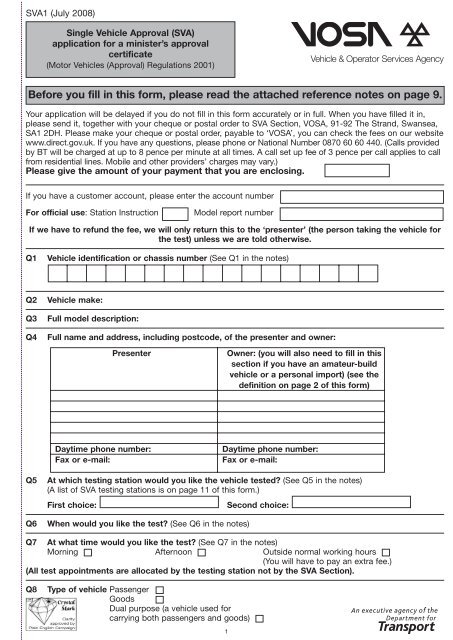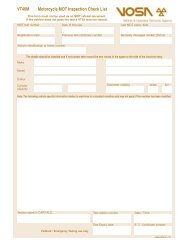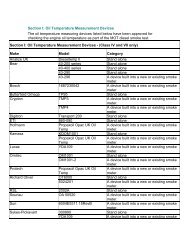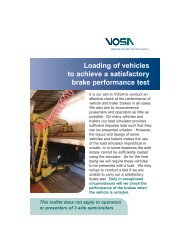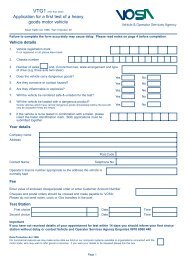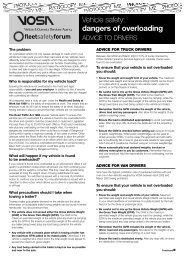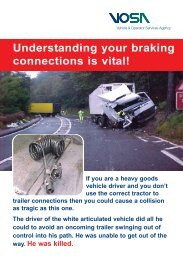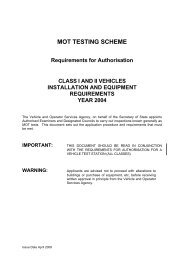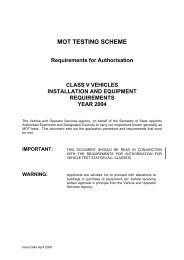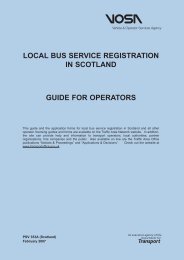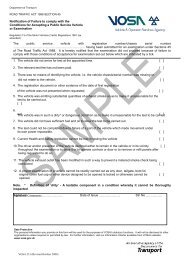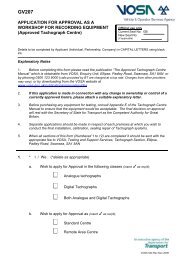Single Vehicle Approval (SVA) - Driving, transport and travel
Single Vehicle Approval (SVA) - Driving, transport and travel
Single Vehicle Approval (SVA) - Driving, transport and travel
Create successful ePaper yourself
Turn your PDF publications into a flip-book with our unique Google optimized e-Paper software.
<strong>SVA</strong>1 (July 2008)<br />
<strong>Single</strong> <strong>Vehicle</strong> <strong>Approval</strong> (<strong>SVA</strong>)<br />
application for a minister’s approval<br />
certificate<br />
(Motor <strong>Vehicle</strong>s (<strong>Approval</strong>) Regulations 2001)<br />
Before you fill in this form, please read the attached reference notes on page 9.<br />
Your application will be delayed if you do not fill in this form accurately or in full. When you have filled it in,<br />
please send it, together with your cheque or postal order to <strong>SVA</strong> Section, VOSA, 9192 The Str<strong>and</strong>, Swansea,<br />
SA1 2DH. Please make your cheque or postal order, payable to ‘VOSA’, you can check the fees on our website<br />
www.direct.gov.uk. If you have any questions, please phone or National Number 0870 60 60 440. (Calls provided<br />
by BT will be charged at up to 8 pence per minute at all times. A call set up fee of 3 pence per call applies to call<br />
from residential lines. Mobile <strong>and</strong> other providers’ charges may vary.)<br />
Please give the amount of your payment that you are enclosing.<br />
If you have a customer account, please enter the account number<br />
For official use: Station Instruction<br />
Model report number<br />
If we have to refund the fee, we will only return this to the ‘presenter’ (the person taking the vehicle for<br />
the test) unless we are told otherwise.<br />
Q1<br />
<strong>Vehicle</strong> identification or chassis number (See Q1 in the notes)<br />
Q2<br />
Q3<br />
Q4<br />
<strong>Vehicle</strong> make:<br />
Full model description:<br />
Full name <strong>and</strong> address, including postcode, of the presenter <strong>and</strong> owner:<br />
Presenter<br />
Owner: (you will also need to fill in this<br />
section if you have an amateurbuild<br />
vehicle or a personal import) (see the<br />
definition on page 2 of this form)<br />
Daytime phone number:<br />
Fax or email:<br />
Daytime phone number:<br />
Fax or email:<br />
Q5<br />
Q6<br />
At which testing station would you like the vehicle tested (See Q5 in the notes)<br />
(A list of <strong>SVA</strong> testing stations is on page 11 of this form.)<br />
First choice:<br />
When would you like the test (See Q6 in the notes)<br />
Second choice:<br />
Q7 At what time would you like the test (See Q7 in the notes)<br />
Morning Afternoon Outside normal working hours<br />
(You will have to pay an extra fee.)<br />
(All test appointments are allocated by the testing station not by the <strong>SVA</strong> Section).<br />
Q8<br />
Type of vehicle Passenger<br />
Goods<br />
Dual purpose (a vehicle used for<br />
carrying both passengers <strong>and</strong> goods)<br />
1
Q9<br />
Class of vehicle<br />
Please tick the appropriate box (or boxes). You may need to tick more than one box for example if it<br />
is in class E (tested by another European Economic Area country). You must tick another box to say<br />
what type of vehicle it is (such as lefth<strong>and</strong> drive, personal import <strong>and</strong> so on). If it is in class R <strong>and</strong> a<br />
disabled person’s vehicle, class D also applies.<br />
N = Left h<strong>and</strong> drive<br />
P = Personal Import A vehicle imported by a person who has lived in the country of export for 12<br />
months or more <strong>and</strong> has owned <strong>and</strong> used the vehicle for six months or more. We will accept the<br />
HM Revenue & Customs clearance form C+E 388 as full proof of personal import (this form is only<br />
available outside the European Community) (EC). If you are not eligible to obtain this form you will<br />
need to send us individual proof of the following: six months ownership (for example a previous<br />
registration document), six months use of the vehicle (for example an insurance certificate covering<br />
a six months period) <strong>and</strong> 12 months residency (for example utility bills covering the last 12 months<br />
from the country of export). You must send us photocopies of these documents <strong>and</strong> you are<br />
required to endorse the copies “certified copies”, these copies must be signed by the applicant<br />
(originals of these documents may be requested at a later date). Please list the photocopies you<br />
have enclosed with the application in the space provided below.<br />
Note 1: The owner of the vehicle must fill in <strong>and</strong> sign the declaration on page 7 of the <strong>SVA</strong>1<br />
application form.<br />
Note 2: Photocopies will be retained by VOSA.<br />
T = Armoured vehicle A vehicle which meets with the armourplating antibullet requirements.<br />
M = Hearse, motor ambulance (optional) or motor caravan (optional)<br />
A = Amateurbuilt A vehicle the majority of which you have built, or which has been built by someone on<br />
your behalf who is not in the business of building motor vehicles, <strong>and</strong> which is for your personal use. You<br />
must provide the kitcar chassis number, not the donorvehicle chassis number (see Q1 in the notes).<br />
Please complete the Amateur Build Declaration which can be downloaded from www.direct.gov.uk or<br />
posted/emailed on request by phoning our national number which is listed on page 1.<br />
C = <strong>Vehicle</strong> built by a person in the business of building vehicles using parts of a vehicle<br />
registered in Great Britain The engine <strong>and</strong> at least one other major part must come from the same<br />
donor vehicle. You must provide the following information:<br />
donor registration number<br />
engine number<br />
list of parts used<br />
S = Rebuilt vehicle A vehicle which:<br />
• has been rebuilt using a replacement chassis or combined chassisbody of the same design as<br />
the original. The chassis or combined chassisbody needs to be new or from a vehicle that has<br />
already been registered in the United Kingdom (UK). Please provide previous registration mark<br />
of the vehicle being rebuilt <strong>and</strong> also details of where the chassis or body has come from (for<br />
example, a receipt).<br />
• your local DVLA office has given a vehicle chassis or identification number to;<br />
• does not meet class ‘A’ or ‘C’; <strong>and</strong><br />
2
L = <strong>Vehicle</strong> manufactured in very low numbers A type of vehicle of which a manufacturer can build<br />
(worldwide) up to 200 vehicles of that ‘family of types’ (or up to 20 of that ‘type variant’) within any 12<br />
month period within the 36 months before the month the vehicle was made.<br />
Note: For a definition of ‘family of type’ or ‘type variant’, please see paragraph 4 of schedule 2 of the<br />
Motor <strong>Vehicle</strong>s (<strong>Approval</strong>) Regulations 2001 (Statutory Instrument 2001/25) on www.hmso.co.uk<br />
R(E<strong>SVA</strong>) = A vehicle that is not in any of the classes shown above <strong>Vehicle</strong>s in this class must<br />
meet the enhanced <strong>SVA</strong> (E<strong>SVA</strong>) test st<strong>and</strong>ards. For more information, see the <strong>SVA</strong> booklet or the<br />
technical st<strong>and</strong>ards in the <strong>SVA</strong> inspection manual.<br />
D = Disabled person’s vehicle A vehicle which is adapted or built so that a disabled person can<br />
<strong>travel</strong> in it, whether as the driver or as a passenger, in safety <strong>and</strong> reasonable comfort. For more<br />
information, see the <strong>SVA</strong> booklet or the technical st<strong>and</strong>ards in the <strong>SVA</strong> inspection manual.<br />
E = European single approval A vehicle that has been found by another country in the European<br />
Economic Area (EEA) to meet the same requirements as the British <strong>Single</strong> <strong>Vehicle</strong> <strong>Approval</strong> (<strong>SVA</strong>).<br />
You must send us a declaration <strong>and</strong> evidence of the technical st<strong>and</strong>ards to which the vehicle<br />
was tested by the authorised testing authority.<br />
NOTE: You can find full definitions of these classes in the Motor <strong>Vehicle</strong>s (<strong>Approval</strong>)<br />
Regulations 2001.<br />
Q10 Please answer the following questions in full for the class (or classes) you ticked in question 9.<br />
The classes below must meet st<strong>and</strong>ard <strong>SVA</strong> test requirements. The test items are checked at a VOSA <strong>SVA</strong><br />
testing station to make sure the vehicle has been designed <strong>and</strong> built to modern safety <strong>and</strong> environmental<br />
st<strong>and</strong>ards.<br />
Class P Please answer questions 11, 12, 13, 14, 15 <strong>and</strong> 16.<br />
Classes N, T <strong>and</strong> M<br />
Please answer questions 11, 12, 13, 14, 15 (this question is only for goods<br />
vehicles) <strong>and</strong> 16.<br />
Classes A, C <strong>and</strong> S Please answer questions 11, 12, 13, 14, 15 <strong>and</strong> 17.<br />
Class L Please answer questions 11, 12, 13, 14, 15 <strong>and</strong> 18.<br />
The class below must meet st<strong>and</strong>ard <strong>SVA</strong> <strong>and</strong> enhanced (E<strong>SVA</strong>) requirements. The st<strong>and</strong>ard <strong>SVA</strong><br />
items will be checked, together with documentary evidence from either the manufacturer of the<br />
vehicle or an independent test laboratory. To cover the enhanced test you must send evidence that<br />
the vehicle meets the necessary European st<strong>and</strong>ards, providing either evidence from the<br />
manufacturer, evidence of a recognised st<strong>and</strong>ard from another country (see the inspection manual) or<br />
evidence from an independent authorised test laboratory (see page 11 of this form). Depending on<br />
the evidence you provide you can also send us a combination of the two.<br />
Class R(E<strong>SVA</strong>) Please answer questions 11, 12, 13, 14, 15, 16 <strong>and</strong> 20.<br />
Class D Please answer questions 11, 12, 13, 14, 15, 16 <strong>and</strong> 20.<br />
The classes below must meet st<strong>and</strong>ard <strong>SVA</strong> test requirements <strong>and</strong> may also need to meet the<br />
enhanced (E<strong>SVA</strong>) requirements.<br />
Class E Please answer questions 11, 12, 13, 14, 15, 16 <strong>and</strong> 19<br />
(<strong>and</strong> 20 if the vehicle also needs an enhanced <strong>SVA</strong> test).<br />
Q11<br />
Please give the date the vehicle was made or first registered. (See Q11 in the notes)<br />
3
Q12 What type of engine does the vehicle have<br />
a) Petrol Diesel Gas Other<br />
b) Turbocharged Nonturbocharged<br />
(Note: Turbocharged includes engines fitted with a supercharger.)<br />
c) Please give the engine size. cc<br />
d) What type of transmission does it have Manual Automatic<br />
e) How many wheels does it have<br />
f) If the vehicle is 4x4, is it: permanent 4x4 selective 4x4<br />
g) How many seating positions (including the driver’s) does the vehicle have<br />
Q13 You must not take the maximum road speed or power engine speed from the vehicle clocks, as they are<br />
unlikely to be the true figures. You should get them from the vehicle h<strong>and</strong>book or by contacting the<br />
manufacturer.<br />
a Maximum road speed:<br />
(see note Q13) (we don’t need this for goods vehicles)<br />
mph<br />
b Maximum power engine speed:<br />
rpm (revolutions per minute)<br />
(revolutions per minute at which maximum power is produced by the engine not maximum<br />
revolutions)<br />
Q14 Is the vehicle fitted with an antilock braking system No Yes<br />
Q15 Only answer this question if you have a goods vehicle. Please give the design weights of the<br />
vehicle. We need the design weights for all goods vehicles <strong>and</strong> vehicles in classes A, C, S <strong>and</strong> L (you<br />
can get the design weights from the vehicle information plate, the vehicle h<strong>and</strong>book or the manufacturer).<br />
(See note Q15)<br />
Axle 1: kg Axle 2: kg Axle 3: kg Gross: kg Train: kg<br />
Q16 Please tell us which country the vehicle was first registered in or where it was first offered for sale<br />
as new.<br />
Q17 If a vehicle is in class A, C or S, please give the date the engine was made. (See note Q17) (At the<br />
time of the test, you must present a letter from the manufacturer or acceptable information that could be<br />
linked to the manufacturer, giving the year the engine was made).<br />
Q18 If the vehicle is in class L, please give the number <strong>and</strong> arrangement of cylinders. (You can get this<br />
information from the manufacturer of the engine.)<br />
Q19 If the vehicle is in class ‘E’, please give the name <strong>and</strong> phone number of an Englishspeaking<br />
representative in the European Economic Area (EEA) country in which the vehicle has been found<br />
to meet an equivalent st<strong>and</strong>ard.<br />
Name:<br />
Phone Number:<br />
4
Q20 If the vehicle is in class R, please complete all questions. (See note Q20)<br />
a<br />
Does the vehicle display a European type approval number on the manufacturer’s plate<br />
No Yes If ‘Yes’, please give the type approval number.<br />
Please also give the recorded mileage (including before any modification).<br />
miles or kilometres<br />
b<br />
Does the vehicle have satisfactory supporting documents of compliance<br />
No<br />
Yes<br />
Supportive documents of compliance may include the following (this is only a guideline).<br />
• A letter from the manufacturer listing the European Community (EC) directives that the vehicle met at<br />
the time the vehicle was made. You must send a copy of this with this application. However, you must<br />
show us the original at the time of the test (see Q20 note 1).<br />
• A Japanese deregistration document or a manufacturer’s certificate of completion, which will cover<br />
certain European Community (EC) directive areas (see the table below for further requirements).<br />
The model designation <strong>and</strong> classification number must be displayed on the document (you should<br />
send a copy with this application <strong>and</strong> show the original at the time of the test). If the model<br />
designation <strong>and</strong> classification numbers are not shown on the Japanese deregistration document or<br />
manufacturer’s certificate of completion, we cannot accept it.<br />
Type of vehicle<br />
Passenger vehicles made between 1 January 1997 <strong>and</strong><br />
30 September 1998 (see the note for 4x4 vehicles with a<br />
separate chassis <strong>and</strong> forwardcontrol vehicles).<br />
Passenger vehicles made between 1 October 1998<br />
<strong>and</strong> 30 September 2003 (see the note for 4x4 vehicles<br />
with a separate chassis <strong>and</strong> forwardcontrol vehicles).<br />
Passenger vehicles made after 30 September 2003 (see<br />
the note for 4x4 vehicles with a separate chassis <strong>and</strong><br />
forwardcontrol vehicles).<br />
Note: All 4x4 passenger vehicles with a separate<br />
chassis (see Q20 note 3). Manufactured prior to<br />
1 January 2000.<br />
Note: Forwardcontrol passenger vehicles made<br />
after 1 October 1997 (see Q20 note 4), <strong>and</strong> prior to<br />
1 January 2000.<br />
Goods vehicles made from 1 January 1997,<br />
depending on class <strong>and</strong> reference mass (see the <strong>SVA</strong><br />
inspection manual or enhanced <strong>SVA</strong> requirements).<br />
Information needed<br />
Japanese deregistration document <strong>and</strong> evidence<br />
that the vehicle meets the noise, emissions, CO2<br />
<strong>and</strong> fuel consumption directives.<br />
Japanese deregistration document <strong>and</strong> evidence that the<br />
vehicle meets the noise, emissions, CO2 <strong>and</strong> fuel<br />
consumption, <strong>and</strong> antitheft directives.<br />
Japanese deregistration document <strong>and</strong> evidence that the<br />
vehicle meets the noise, emissions, CO2 <strong>and</strong> fuel<br />
consumption, <strong>and</strong> antitheft directives.<br />
As well as those requirements above, you also need<br />
evidence that the vehicle meets the protective steering<br />
directive.<br />
As well as those requirements above, you also need<br />
evidence that the vehicle meets the protective steering<br />
directive.<br />
Evidence that the vehicle meets the noise <strong>and</strong> emissions<br />
directives <strong>and</strong> evidence of Japanese deregistration for<br />
brakes.<br />
You can get evidence that the vehicle meets the directives listed above from either an existing model report<br />
owner (if a model report is available) or you can get information on this from <strong>SVA</strong> Section, Swansea or an<br />
independent test laboratory (see the list of independent test laboratories on the enclosed sheet ‘Stations <strong>and</strong><br />
test laboratories’ or www.vosa.gov.uk).<br />
5
c<br />
Is the vehicle a ‘oneoff’ with supportive documents<br />
The supportive documents will normally include a test report from an independent test laboratory (see<br />
the list of independent test laboratories on pages 11 <strong>and</strong> 12 of this form ‘Stations <strong>and</strong> independent test<br />
laboratories’).<br />
No<br />
Yes<br />
If ‘Yes’, please give the test report number.<br />
d<br />
Is the vehicle a precedent vehicle that has a model report<br />
A ‘precedent’ vehicle is one where any tests provided include extra information to allow a ‘model’ report<br />
to be created. The model report can be used to examine more vehicles of the same specification (see<br />
Q20 note 7.)<br />
No<br />
Yes<br />
If ‘Yes’, please give the test report number (or numbers).<br />
e Is the vehicle to be assessed against an existing model report (see Q20 note 7)<br />
No<br />
Yes<br />
If ‘Yes’, please give the model report number.<br />
f<br />
Is the vehicle to be tested based on modelspecific information the manufacturer has already<br />
given to us (see Q20 note 2)<br />
No<br />
Yes<br />
g Is the vehicle a 4x4 with separate chassis (see Q20 note 3)<br />
No<br />
Yes<br />
h Is the vehicle a ‘forwardcontrol vehicle’ (see Q20 note 4)<br />
No<br />
Yes<br />
i<br />
Is the vehicle a passenger vehicle made after 1 October 1998 <strong>and</strong> fitted with:<br />
• an immobiliser No Yes<br />
• an alarm No Yes<br />
If you answer ‘Yes’ to either of these questions, you need to provide evidence of compliance<br />
(see Q20 note I).<br />
j<br />
Is the vehicle now a passenger vehicle that has no more than eight passenger seats (not including<br />
the driver’s) which was converted from a passenger vehicle that had more than eight passenger<br />
seats or from a goods vehicle<br />
No<br />
Yes<br />
If ‘Yes’, please provide evidence of vehicle’s previous category.<br />
k<br />
Is the vehicle now a passenger vehicle that has no more than eight passenger seats which was<br />
converted from a goods vehicle that has a design weight of 1500 kilograms or more<br />
No<br />
Yes<br />
Please provide the original design weight.<br />
kilograms<br />
6
l Is the vehicle now a passenger vehicle that :<br />
• was made on or after 1 October 2003<br />
No<br />
Yes<br />
• has a manufacturer’s design weight of more than 2000 kilograms<br />
No<br />
Yes<br />
If ‘Yes’, please give the design weight.<br />
kilograms<br />
• has a seat reference point (of the lowest front seat) of more than 700 millimetres above the ground<br />
(see Q20 note 5)<br />
No<br />
Yes<br />
m Is the vehicle a goods vehicle (see Q20 note 6)<br />
No<br />
Yes<br />
If ‘Yes’, please give the reference mass.<br />
Data Protection Act 1998<br />
For commercial reasons we may make some information we hold on our computer systems available to organisations<br />
connected with the motor trade, who may want to offer you goods or services. If you want us to give your details to these<br />
organisations, please tick this box.<br />
Declaration<br />
I confirm that, as far as I know, all statements in this application are true. If this application is for a<br />
personal import, the vehicle is for my personal or household use in the United Kingdom <strong>and</strong> I do not<br />
intend to sell it in the immediate future.<br />
I agree to use the model report procedure on the conditions that apply to the compliance check<br />
arrangements described in the notes of this form.<br />
Signature:<br />
Full Name: Date: / /<br />
7
Reference notes<br />
Safety notice: If the vehicle is fitted or supplied with a pyrotechnic warning flare, please<br />
remove it (<strong>and</strong> its holder) from the vehicle before you bring the vehicle for the test.<br />
Q1 You can find the vehicle identification <strong>and</strong> chassis number on the manufacturer’s information plate<br />
under the bonnet, around the door opening or on a previous registration document. If we consider the<br />
number to be unsuitable, we will refer you to your local DVLA office, who will give you a suitable number.<br />
Please make sure you write the number in full. If it is an amateurbuilt vehicle, please provide the kitcar<br />
chassis number, not the donor chassis number.<br />
Q5 Please provide a second choice of test station, as an appointment at your first choice test station may<br />
not be available (there is a list of <strong>SVA</strong> test stations on page 11 of this form). <strong>Vehicle</strong>s in classes N, P <strong>and</strong> R<br />
that fail a test can be tested again at any <strong>SVA</strong> test station. Other classes of vehicle must be tested at the<br />
same <strong>SVA</strong> testing station as the original test.<br />
Q6 <strong>and</strong> Q7 Please give your preferred test date <strong>and</strong> time. The test station will give an appointment, as near<br />
as possible to the date <strong>and</strong> time you prefer, when they receive your application. Testing outside ‘normal’<br />
hours may be available at certain test stations. These times would be before 8am or after 5pm Monday to<br />
Thursday, before 8am or after 4.30pm on Fridays or at any time at weekends or bank holidays. You would<br />
have to pay an extra fee for testing outside normal working hours. The test station will contact you if this<br />
service is available.<br />
Q11 You can get the date your vehicle was made from the manufacturer’s information plate or from the<br />
manufacturer. If the vehicle had been registered before, you can give the date it was first registered instead.<br />
Q13 We may use manufacturer’s information where available, instead of the information you have given on<br />
the application form, unless you send us satisfactory documentary evidence to support the declaration.<br />
Q15 Design weight is the maximum weight that the vehicle is built to carry when fully loaded. The gross<br />
weight refers to the weight of the whole vehicle. The axle weight is the maximum weight an axle can carry.<br />
The train weight, for a vehicle fitted with a towing attachment, is the maximum weight of the vehicle <strong>and</strong><br />
trailer when loaded.<br />
Q17 At the time of examination, you will need to provide evidence of the date the engine was made. If you<br />
fail to supply this evidence, the vehicle will be tested to a higher emission st<strong>and</strong>ard.<br />
Q20 <strong>Vehicle</strong>s in class R will need to meet the enhanced <strong>SVA</strong> requirements as well as the st<strong>and</strong>ard <strong>SVA</strong><br />
requirement.<br />
20c A ‘oneoff’ vehicle is one that will be tested as an individual vehicle where the information provided will<br />
not be used for future applications.<br />
20d A ‘precedent’ vehicle is one where any tests provided include extra information to allow a ‘model<br />
report’ to be created. The model report can be used as a basis to examine more vehicles of the same<br />
specification.<br />
If you put forward a vehicle using a model report (that is, you answer ‘Yes’ to question 20d or 20e), you<br />
should be prepared to remove or dismantle trim <strong>and</strong> other parts so that the testing station can gain access<br />
to critical parts.<br />
9
(Q20 notes continued).<br />
Note 1 Relevant directives relating to a goods vehicle are those relating to brakes, noise <strong>and</strong><br />
emissions.<br />
Relevant directives relating to a passenger vehicle are those relating to seatbelt anchorages, protective<br />
steering, noise <strong>and</strong> silencers, exhaust emissions, brakes, seatbelt installation, fuel consumption <strong>and</strong> CO2,<br />
antitheft, frontal impact <strong>and</strong> side impact. For passenger vehicles made from 1 October 1998, you must<br />
show us evidence from the vehicle manufacturer or an authorised test laboratory, or an original certificate<br />
of installation from an approved installer for an immobiliser that meets the European directive requirements<br />
at the time of test. If the vehicle has an alarm fitted, we will need evidence that it meets the necessary<br />
st<strong>and</strong>ards. This will need to be a certificate from an accredited installer either <strong>Vehicle</strong> Security Installation<br />
Board (VISB) (phone 0870 5502006 or visit www.visib.co.uk) or Mobile Electronic Security Federation<br />
(MESF) (phone 01376 561040 or visit www.mesf.org.uk). You may be able to get the relevant directive<br />
information that the vehicle was built to from the vehicle manufacturer. If you cannot get this information<br />
from the manufacturer, you will need to contact an independent test laboratory (see the sheet ‘Stations <strong>and</strong><br />
independent authorised test laboratories’).<br />
Note 2 This only applies to certain Nissan D22 <strong>and</strong> Mitsubishi L200 (applied model code K64T <strong>and</strong> K74T)<br />
goods vehicles.<br />
Note 3 A passenger vehicle meeting the following definition may need a model report for protective<br />
steering. For example, a 4x4 that has a separate chassis is a motor vehicle that has a frame chassis (that<br />
is, separated from the body) <strong>and</strong> to which the engine <strong>and</strong> front <strong>and</strong> rear suspension are attached <strong>and</strong> on<br />
which the engine power can be transmitted to all wheels.<br />
Note 4 A passenger vehicle meeting the following definition may need a model report for protective<br />
steering. ‘Forward control’ means that more than half of the engine length (engine length including fan,<br />
generator <strong>and</strong> air cleaner if fitted to the engine, but not radiator, silencer, clutch or transmission) is behind<br />
the most forward point of the windscreen.<br />
Note 5 A passenger car would normally have a reference point below 700mm. For guidance only, it can be<br />
assessed with the front seat (if adjustable) in it’s middle position <strong>and</strong> by placing a rectangular block<br />
measuring 136mm long <strong>and</strong> 53mm high onto the back of the seat cushion against the back rest. The<br />
forward upper edge is the height of the reference point. If the measurement is close to the critical point<br />
(that is, above 700mm), you should get advice from us, the manufacturer or a test laboratory.<br />
Note 6 The ‘reference mass’ is the weight of the vehicle with bodywork (including coolant, oils, fuel, tools,<br />
spare wheel <strong>and</strong> a driver) plus 25kg.<br />
Note 7 If you want your vehicle to be tested using a model report, you should be prepared to remove or<br />
dismantle trim <strong>and</strong> other parts so that the testing station can get access to critical parts.<br />
Compliance check<br />
If you want your vehicle to be tested against an existing model report (that is, you answer ‘Yes’ to question<br />
20e), we may choose to carry out a ‘compliance check’. This is a check we carry out on a sample of<br />
vehicles to make sure that:<br />
• they are built to the same specification as the original vehicle described in the model report (the<br />
original vehicle having been tested <strong>and</strong> found to meet the relevant enhanced requirements); <strong>and</strong><br />
• they actually meet the enhanced requirements <strong>and</strong> are built to the specification described in the<br />
model report.<br />
The compliance check is part of the ‘approval’ process. If we decide to carry out the check on your vehicle,<br />
we will tell you when you bring the vehicle for the test. You will have to leave the vehicle at the test station.<br />
We will then <strong>transport</strong> it to an independent test laboratory, who will carry out a full check of the vehicle<br />
against the relevant model report. You may claim a refund of the cost of your intended return journey to your<br />
home or place of work. We will not charge for <strong>transport</strong>ing the vehicle to or from the laboratory or for the<br />
compliance check. The process is likely to take around two weeks. We will tell you when the check has been<br />
completed, when the vehicle will be returned to the test station, <strong>and</strong> the result of the check.<br />
The result of this compliance check can affect the future use of the model report in question. The model<br />
report may have to be exp<strong>and</strong>ed or, in certain extreme cases, can no longer be used.<br />
10
Stations <strong>and</strong> independent authorised test laboratories<br />
VOSA test stations <strong>and</strong> phone numbers<br />
Aberdeen<br />
Cloverhill Road, Bridge of Don Industrial Estate, Aberdeen,<br />
01224 702357<br />
AB23 8FE<br />
Avonmouth VOSA, Unit 10, I.O. Centre, Cabot Park, Avonmouth, Bristol, BS11 0QL 0117 938 1157<br />
Beverley<br />
Oldbeck Road, Off Grovehill Road, Beverley, North Humberside, 01482 881522<br />
HU17 0JW<br />
Birmingham Garretts Green Industrial Estate, Birmingham, B33 0SS 0121 783 6560<br />
Cardiff (Llantrisant) School Road, Miskin, Pontyclun, Mid Glamorgan, CF72 8YR 01443 224701<br />
Carlisle Brunthill Road, Kingstown Industrial Estate, Carlisle, CA3 0EH 01228 528106<br />
Chelmsford Widford Industrial Estate, Chelmsford, Essex, CM1 3AE 01245 259341<br />
Derby Curzon Lane, Alvaston, Derby, DE24 8XB 01332 571961<br />
Exeter Grace Road, Marsh Barton Trading Estate, Exeter, Devon, EX2 8PH 01392 217276<br />
Gillingham Ambley Road, Gillingham, Kent, ME8 0SJ 01634 232541<br />
Glasgow (Bishopbriggs) Crosshill Road, Bishopbriggs, Glasgow, G64 2QA 0141 772 6321<br />
Leighton Buzzard Stanbridge Road, Leighton Buzzard, Bedfordshire, LU7 8QG 01525 373074<br />
London North (Edmonton) Towpath Road (off Harbet Road), Lea Valley Trading Estate,<br />
020 8803 7733<br />
Edmonton, N18 3JR<br />
London South (Mitcham) Redhouse Road, Croydon, Surrey, CR0 3AQ 020 8684 1499<br />
London West (Yeading) Cygnet Way, Willow Tree Lane, Yeading, Hayes, Middlesex, UB4 9BS 020 8841 9205<br />
North Manchester<br />
Broad Gate, Broadway Business Park, Chadderton, Oldham, OL9 9XA 0161 947 1000<br />
(Chadderton)<br />
Newcastle upon Tyne S<strong>and</strong>y Lane, Gosforth, NewcastleuponTyne, NE3 5HB 0191 236 5011<br />
Norwich Jupiter Road, Hellesden, Norwich, NR6 6SS 01603 408128<br />
Nottingham Main Road, Watnall, Nottingham, NG16 1JF 0115 938 2591<br />
Shrewsbury Ennerdale Road, Harlescott, Shrewsbury SY1 3LF 01743 462621<br />
Southampton (Northam) Unit R Centurion Industrial Estate, Bitterne Road West, Southampton, 02380 837397<br />
SO18 1UB<br />
Taunton<br />
Taunton Trading Estate, Norton Fitzwarren, Taunton, Somerset<br />
TA2 6RX<br />
01823 282525<br />
Independent authorised test laboratories <strong>and</strong> their phone numbers In the United Kingdom<br />
Aveley Emissions<br />
Laboratory (AEL)<br />
Dunton Emission<br />
Laboratory<br />
L<strong>and</strong>rover<br />
Arcany Road, off Airsdale Avenue, South Ockendon,<br />
Essex, RM15 5TB<br />
Dunton Technical Centre, Laindon, Basildon,<br />
Essex, SS15 6EE<br />
Block 105, Lode Lane, Solihull, West Midl<strong>and</strong>s,<br />
B92 8NW<br />
Tel: 01708 858604<br />
Fax: 01708 858607<br />
Tel: 01268 403271<br />
Fax: 01268 401309<br />
Tel: 0121 700 3184<br />
0121 700 3010<br />
LTC Ltd Aston Way, Leyl<strong>and</strong>, Preston, PR5 3TZ Tel: 01772 422911<br />
Fax: 01772 621466<br />
Millbrook Proving<br />
Ground Ltd<br />
NAC MG (UK) Ltd<br />
Emissions Laboratory<br />
Status<br />
The Motor Industry<br />
Research Association<br />
(MIRA)<br />
Millbrook, Bedford, MK45 2JQ Tel: 01525 408253<br />
01525 408362<br />
Fax: 01525 408406<br />
Lickey Road, Longbridge, Birmingham, B31 2TB Tel: 0121 251 3840<br />
0121 251 3849<br />
contact Tim Colgan<br />
Department of Engineering <strong>and</strong> Technology<br />
Manchester Metropolitan University, John Dalton<br />
Building, Chester Street, Manchester, M1 5GD<br />
Power Train <strong>and</strong> Emissions Technology,<br />
Watling Street, Nuneaton, Warwickshire, CV10 0TU<br />
Tel: 0161 247 6240<br />
Tel: 0247 635 5029<br />
or 0247 635 5178<br />
Torotrack Plc 1 Ashton Way, Leyl<strong>and</strong>, Preston, PR26 7UX Tel: 01772 900900<br />
Fax: 01772 900929<br />
TRL Ltd<br />
Emissions Laboratory<br />
(UK) Ltd<br />
Old Wokingham Road, Crowthorne, Berkshire,<br />
RG45 6AU<br />
Unit 25, European Way, Eastern Dock,<br />
Southampton, Hampshire, SO14 3XD<br />
11<br />
Tel: 01344 770765<br />
Fax: 01344 77918<br />
Tel: 02380 631550<br />
Fax: 02380 631551<br />
Emissions<br />
Emissions<br />
Emissions only<br />
Noise, Brakes, &<br />
Seat Belt<br />
Anchorages –<br />
Comparison test’s<br />
Noise, Emissions &<br />
Brakes Seat Belt<br />
Anchorages, Front<br />
& Side Impact,<br />
Protective Steering<br />
Emissions<br />
Noise, Emissions,<br />
Brakes, Seat Belt<br />
Anchorages, Front<br />
& Side Impacts,<br />
Protective<br />
Steering<br />
Emissons only<br />
Noise only<br />
Emissions, Noise<br />
& Comparisons
Other Countries<br />
Emission Laboratory<br />
(HK) Ltd<br />
ETC HK Ltd<br />
Eurotype Test Centre<br />
(PTY) Ltd<br />
RWTUV Fahrzeug<br />
GmbH<br />
TUV Nord Mobilitat<br />
GmbH & Co. KG<br />
Hong Kong Exhaust<br />
Emission Laboratory<br />
Ltd (HKEEL)<br />
G/F, Flat B, Lok Shun Factory Building,<br />
628 Chai Wan Kok Street, Tsuen Wan,<br />
Kowloon, NT, Hong Kong<br />
G/F, Unit B, No 7, Mok Cheong Street, Tokwawan<br />
Kowloon, Hong Kong<br />
PO Box 5486, Greenfields, East London, 5208<br />
South Africa<br />
Gesamtfahrzeug, Fachgebiet, Sonderfahrzeuge,<br />
Nutzfahrzeuge und Kaftrader, Leiter des referats,<br />
Essen, Adlerstr. 7, 45307 Essen Germany<br />
Institute for <strong>Vehicle</strong> Technology & Mobility, Exhaust<br />
Emission Test Center Hannover, Am TUV 1,<br />
30519 Hanover, Germany<br />
G/F Flat B, Lok Shun Factory Building,<br />
628 Chai Wan Kok Street, Tsuen Wan, Kowloon,<br />
NT, Hong Kong<br />
Tel:+852 2499 2772<br />
contact Derek Lennie<br />
Tel: +852 2264 2299<br />
Tel: +27 43 7031602<br />
Tel: +49 201 825<br />
4142<br />
Tel: +48 5119 861<br />
334<br />
Tel: +852 2475 3661<br />
contact Norman Wei<br />
Emissions <strong>and</strong><br />
Noise<br />
Emissions <strong>and</strong><br />
noise<br />
Emissions <strong>and</strong><br />
noise<br />
Emissions<br />
VOSA503<br />
12


